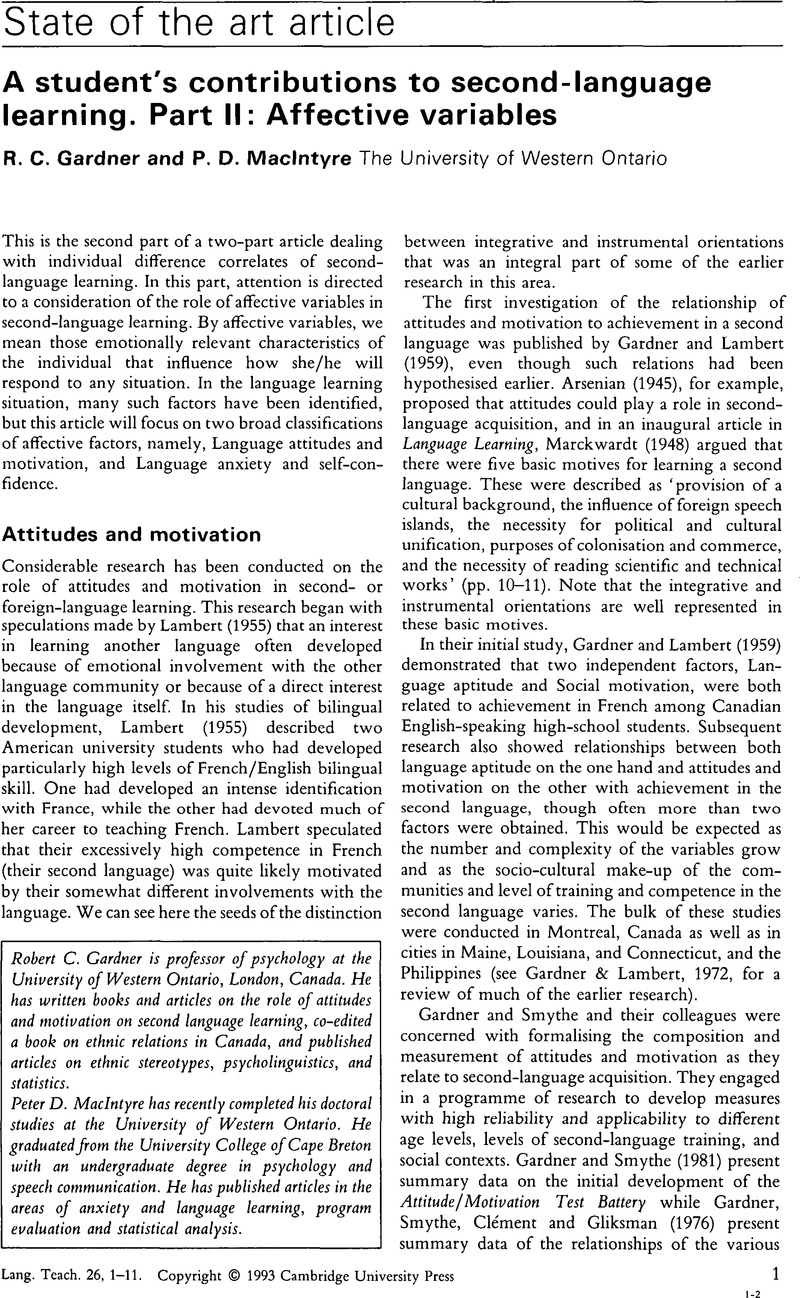Crossref Citations
This article has been cited by the following publications. This list is generated based on data provided by Crossref.
DÖRNYEI, ZOLTÁN
1994.
Motivation and Motivating in the Foreign Language Classroom.
The Modern Language Journal,
Vol. 78,
Issue. 3,
p.
273.
Maclntyre, Peter D.
1994.
Toward a Social Psychological Model of Strategy Use.
Foreign Language Annals,
Vol. 27,
Issue. 2,
p.
185.
GARDNER, R. C.
and
TREMBLAY, P. F.
1994.
On Motivation, Research Agendas, and Theoretical Frameworks1.
The Modern Language Journal,
Vol. 78,
Issue. 3,
p.
359.
DÖRNYEI, ZOLTÁN
1994.
Understanding L2 Motivation: On with the Challenge!.
The Modern Language Journal,
Vol. 78,
Issue. 4,
p.
515.
Dickinson, Leslie
1995.
Autonomy and motivation a literature review.
System,
Vol. 23,
Issue. 2,
p.
165.
MACINTYRE, PETER D.
1995.
How Does Anxiety Affect Second Language Learning? A Reply to Sparks and Ganschow.
The Modern Language Journal,
Vol. 79,
Issue. 1,
p.
90.
SPARKS, RICHARD L.
and
GANSCHOW, LEONORE
1995.
A Strong Inference Approach to Causal Factors in Foreign Language Learning: A Response to MacIntyre.
The Modern Language Journal,
Vol. 79,
Issue. 2,
p.
235.
Truscott, John
1996.
The Case Against Grammar Correction in L2 Writing Classes.
Language Learning,
Vol. 46,
Issue. 2,
p.
327.
MacIntyre, Peter D.
and
Charos, Catherine
1996.
Personality, Attitudes, and Affect as Predictors of Second Language Communication.
Journal of Language and Social Psychology,
Vol. 15,
Issue. 1,
p.
3.
Coleman, James A.
1997.
Residence abroad within language study.
Language Teaching,
Vol. 30,
Issue. 1,
p.
1.
GARDNER, R. C.
TREMBLAY, PAUL F.
and
MASGORET, ANNE‐MARIE
1997.
Towards a Full Model of Second Language Learning: An Empirical Investigation.
The Modern Language Journal,
Vol. 81,
Issue. 3,
p.
344.
Multhaup, Uwe
1997.
Mental networks, procedural knowledge and foreign language teaching.
Language Awareness,
Vol. 6,
Issue. 2-3,
p.
75.
Daoud, Sada A
1998.
How to motivate EFL learning and teaching of academic writing by cross-cultural exchanges.
English for Specific Purposes,
Vol. 17,
Issue. 4,
p.
391.
Dörnyei, Zoltán
1998.
Motivation in second and foreign language learning.
Language Teaching,
Vol. 31,
Issue. 3,
p.
117.
1998.
References.
Language Learning,
Vol. 48,
Issue. s1,
p.
253.
Lamb, Terry
and
Fisher, James
1999.
Making connections: football, the internet and reluctant language learners.
The Language Learning Journal,
Vol. 20,
Issue. 1,
p.
32.
Gardner, R. C.
Masgoret, Anne-Marie
and
Tremblay, Paul F.
1999.
Home Background Characteristics and Second Language Learning.
Journal of Language and Social Psychology,
Vol. 18,
Issue. 4,
p.
419.
Dörnyei, Zoltán
and
Kormos, Judit
2000.
The role of individual and social variables in oral task performance.
Language Teaching Research,
Vol. 4,
Issue. 3,
p.
275.
Hotho, Sabine
2000.
“Same” or “Different”? A Comparative Examination of Classroom Factors in Second Language Settings.
Foreign Language Annals,
Vol. 33,
Issue. 3,
p.
320.
Dörnyei, Zoltán
2001.
Handbook of Pragmatics.
p.
1.



